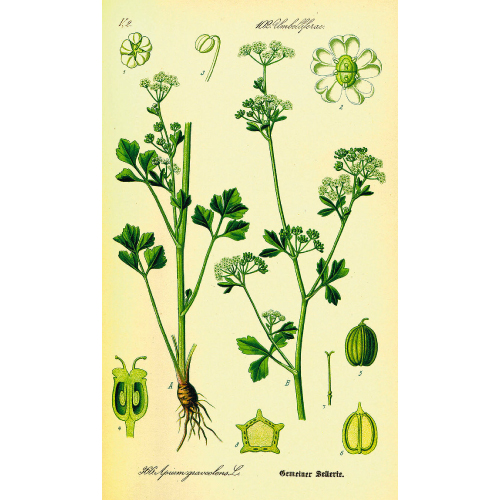PURE AND CHEMOTYPED CELERY ESSENTIAL OIL
APIUM GRAVEOLENS
Plant Organ: Seed
Optimal ranges of biochemical composition:
- Limonene 60-75%
- Beta-selinene 5-15%
- Sedanolide ≤8%
General information and properties:
Celery essential oil has draining, liver and kidney detoxifying properties due to its limonene and phthalides content, including sedanolide. Helps drain the urinary and bile tracts. Its depigmenting action is related to sedanolide and other phthalides that act directly on pigments and brown spots and age spots through detoxification.
It is known to have a stimulating and toning action on the body in general due to its hepatostimulant action.
Limonene and sedanolide also give this essential oil an anxiolytic action that helps control stress and anxiety.
correct traditional indications
Dermatology
Dark spots on the skin (brown, age spots)
Dilute 1 drop of Celery essential oil in 20 drops of Rosehip or Grape vegetable oil and apply to the affected area, twice a day for three weeks. Take a 1 week break and repeat if necessary.
gastroenterology
Hepatorenal failure ++++
Dilute 1 drop of Celery essential oil with 1 drop of Lemon essential oil in a teaspoon of Olive oil and take half an hour before each meal.
dyspepsia, difficult digestion
Dilute 1 drop of Celery essential oil in 20 drops of Argan vegetable oil and apply in a circular massage on the belly up to 3 times a day when necessary.
Neurology
Anxiety, Stress
Dilute 1 drop of Celery essential oil in 20 drops of Argan or Jojoba vegetable oil.
Massage along the spine, 2 times a day. Take a week break after 3 weeks of use.
Do not apply during pregnancy or during lactation.
Do not apply to babies under 3 years of age.
Do not apply inhaled. It can be applied diluted in diffusion with other essential oils.
This essential oil contains coumarins. Avoid sun exposure for 8 hours after application.
Do not apply pure on the skin; For topical use, dilute it in a vegetable oil in a proportion equivalent to 5%.
Permitted use according to age or condition of the patient:
-
- Children under 6 years: no
-
Babies under 3 years old: no
Safe application routes:
-
-
-
-
Risks of using essential oil:
- Photosensitizer: yes
- Hormonal interaction with estrogen: no
- General hormonal interaction: no
- Liver toxicity: no
- Neurotoxicity: no
- Irritating to the respiratory tract: no
- Allergy risk: yes
- Dermocaustic (burns the skin if used neat): no
- Skin irritation if used neat: yes
- Cortisone-like effect: no
Warnings on the use of essential oils:
The information on traditional use is not a substitute for the advice of a pharmacist or aromatherapy physician. Its use without attending to said recommendation will always be under your responsibility. If in doubt, it is recommended to consult your doctor. It is important to confirm the diagnosis of your disease or condition to make the best decision. It is especially important to review the contraindications and precautions for use of each essential oil. The indications and contraindications of an essential oil depend on its molecular composition. The traditional uses reported refer to essential oils and 100% pure vegetable oils with detailed information on origin, quality and specific molecular composition ranges for a SAFE AND EFFECTIVE AROMATHERAPY. THEY DO NOT APPLY TO ANY ESSENTIAL OIL THAT DOES NOT COMPLY WITH THIS INFORMATION. QUALITY GLOBAL SAS AND/OR DOCTOR SALIARMO VALDERRAMA AND/OR AROMATMA SAS is/are not responsible for inappropriate and/or abusive use of essential oils and vegetable oils. Allergy: Before using an essential oil, it is advisable to apply a drop on the inside of the elbow and wait 24 hours in order to demonstrate a possible allergic reaction. It is appropriate to consult the chapter entitled "Risks of using essential oil" if the icon "Allergy risks" appears.

Bibliography:
- De la Charie, T. et al. Website « Compagnie des Sens » – https://www.compagnie-des-sens.fr/
- Franchomme, P., R. Jollois, and D. Pénoël. 2001. L'aromathérapie Exactly. Encyclopédie de L'utilisation Thérapeutique Des Huiles Essentielles. Editions Roger Jollois.
- Zhiri A., Baudoux D. Huiles essentielles chémotypées et leurs synergies.
- Passport Santé. Website https://www.passeportsante.net/
- Scott A. Johnson, 2015. Evidence-based essential oil therapy the ultimate guide to the therapeutic and clinical application of essential oils (EBEO)
- https://vanessences.fr/content/28-huile-essentielle-encens-bienfaits-proprietes-utilisation

